The Battle of High-End Annual Calendars Part 1 – A. Lange & Söhne 1815 Annual Calendar
A mid-range complication, a manual calibre, a practical pusher, traditional aesthetics and excellent legibility... this watch is here to stay.

The 1815 Annual Calendar is the second complication of this genre in A. Lange & Söhne‘s current line-up. Following the launch of the Saxonia Annual Calendar in 2010 with an automatic movement and outsized date window, Lange came out with the 1815 manual-winding/analogue date Annual Calendar at the beginning of 2017. Two years might have passed, but there’s no getting tired of this classic beauty. Released in pink and white gold, we had the more understated white gold model for our hands-on session.
Editor’s note: this review of the A. Lange & Söhne 1815 Annual Calendar is part of a series of three articles where we will compare two of the most desirable high-end, hand-wound Annual Calendar watches currently on the market. Two watches with the same concept, but two different flavours. The third article, which will be published after our two separate reviews, will pit them side-by-side.
Evoking the founder, attracting a new client base
You won’t find any of the features we so often associate with Lange watches – off-centred dials and the outsize date window – on this particular model or for that matter in the 1815 family. For that, there is the Saxonia Annual Calendar. The 1815 Annual Calendar embraces a different, more classic aesthetic in keeping with the design ethos of the 1815 watch family. Introduced in 1996 as a tribute to the year Ferdinand Adolph Lange was born, the design of the 1815 collection evokes details of F.A. Lange’s precision pocket watches and can be distinguished from the other four Lange families by the characteristic railway track minute scale, the Arabic numerals and, in many cases, the blued hands.
Ranging from simple time-only models to rattrappante chronographs, from perpetual calendars and tourbillons to the superlatively complex Grand Complication, there was room in the 1815 collection for a mid-range complication like an annual calendar. Touted as the “entry-level complication watch” of the brand, the 1815 Annual Calendar retails for EUR 38,300 – that’s EUR 7,600 less than the automatic Saxonia Annual Calendar in white gold. Not a bargain by any stretch of the imagination, but this is Lange after all and is certainly a price tag that might appeal to somebody on the hunt for his/her first high-end watch with a satisfying sprinkling of complications and high-wearability factor.
A traditional case with a pragmatic pusher
The case measures 40mm in diameter and has that reassuring weight that only a gold watch can offer. I can understand why so many watch fans are bewitched by ultra-thin, ultra-light watches, but I like to feel the presence of my watch on my wrist. I also understand that 40mm might not quite cut it with purists, but the short lugs and relatively thin waistline of 10.1mm attenuate the diameter. For my wrist, 40mm might be pushing it sizewise, but I was surprised by how comfortable the watch wears. And as you can see, the watch looks perfectly proportioned on Frank’s 18.5cm wrist (on the photos).
The finishes, as with all Lange watches, are exquisite with polished surfaces (bezel and top of lugs) and a contrasting brushed caseband. And then there is the understated appeal of white gold and that special lustre that only this metal can conjure.
Given the Saxon penchant for practicality, adjusting the functions is dead simple. The rectangular pusher at 2 o’clock allows you to advance all the indications simultaneously, a very useful device if you have forgotten to wind the watch. You can also advance the date separately using a recessed push-piece, the first time this option has ever been available in a Lange calendar model, while three additional recessed push pieces also allow for the separate corrections of the day, month and moon phase, respectively.
Circles within circles
The layout of the elements on the silvered dial forms a subtle pattern of circles within circles. Everything is where it should be and everything is legible… And there is a lot of writing on this dial! The railway track minute scale, a common denominator of the 1815 family, provides a visual bridge to F.A. Lange’s precision pocket watches, hot commodities in the early days of rail travel for stationmasters and travellers alike.
Above each hour numeral is a small black dot and the size of the “track” housing the dot is extended to accommodate the height of the numeral. If you look closely at 3, 6, 9 and 12 o’clock, you’ll see a small treble-shaped design composed of three little dots and a small stick. Browsing the A. Lange & Söhne The Watchmakers of Dresden book, I spotted some early 20th-century J. Assmann pocket watches with this same design feature, as well as several Lange pocket watches with complications like the handsome gold hunter with quarter repeater (no.60104) of 1908. I bet there is even a technical word for these tiny trebles, does anybody out there know what that term might be?
The large Arabic numerals are a direct throwback to pocket watch dials. They are so glossy and plump, you might suspect that the paint is still wet! I love the artisanal rendition of these printed numerals and the way they stand out against the matte silvered dial. And, as much as I love the numerals, I have to admit that there is one small design choice that bugs me: the way the numbers 3, 6 and 9 have been truncated by the sub-dials.
Annual Calendar
An annual calendar is one of the most practical calendar complications with day, date and month functions. Not quite as sophisticated as a perpetual calendar and usually easier on the pocket, an annual calendar requires just one adjustment a year; the mechanism of this model treats February as a 30-day month requiring one manual correction on 1 March. Although the annual calendar is a relatively recent newcomer on the complication scene (created by Patek in 1996), the layout of the 1815 Lange is traditional to the core.
A subtle recessed circle in the centre of the dial hosts the two calendar sub-dials and the running seconds with moon-phase indicator at 6 o’clock. The two calendar counters are aligned horizontally on a central axis – on the left, days and date (analogue), on the right, months. All the inscriptions on the dial are black, save for the first day of the month signalled in red. What is also visually arresting is the way the three sub-dials push out beyond the confines of the central area invading the hour markers. They are, after all the protagonists and are comfortably seated allowing a generous view of the snailing in their interiors. Like the central area, they are also recessed adding depth and interest to the dial.
Echoing the railway minute track, the small seconds counter also features a black railway seconds track. In it its interior, the moon transits through its different phases against a blue star-spangled sky with traces of the Milky Way. The precision of the waxing and waning of our celestial neighbour is impressive and will remain accurate for 122.6 years. The hands of the sub-dials are made from white gold and plated with rhodium, while the central hour and minute hands are blued steel in the exact same colour as the sky of the moon-phase indicator. The attention to detail is exceptional and to provide as clear a view as possible on the night sky, the counterweight of the small seconds hand is openworked.
Manual-winding calibre L051.3
The incorporation of a manual-winding movement was the brand’s way of honouring F.A. Lange’s crown winder, patented in the USA in 1866 and designed to replace key-operated winding works. However, if you think about the usefulness and practicality of an annual calendar, the choice of a manual-winding movement over an automatic is kind of quirky, almost anachronistic in keeping with the traditional tenets of the 1815 family. In fact, if you look around, most annual calendar watches are automatic so that makes this Lange model even more special.
The hallmark German silver three-quarter plate with Glashütte stripes dominates most of the scenery on the caseback complete with the signature hand-engraved balance cock and the touches of colour provided by the screwed gold chatons with rubies and blued screws. What is unusual here is that the ratchet and crown wheels have been integrated into the upper segment of the 3/4 plate and are on full view. Calibre L051.3, based on L051.1 movement of the three-hand 1815 model, is fitted with an ultra-thin 1.4mm high annual calendar module. With a height of just 5.7mm, the movement provides a power reserve of 72 hours, more than enough to get you through the weekend.
Price and Availability
The A. Lange & Söhne 1815 Annual Calendar comes on a black hand-stitched alligator strap with a white gold pin buckle. The watch is currently under production and thus available at Lange boutiques and retailers. The retail price is EUR 38,300 (incl. taxes). More on www.alange-soehne.com.
Tomorrow we’ll be reviewing another annual calendar with a very different temperament and then, we’ll simulate a battle between both models and pronounce our verdict on the winner. Stay tuned.

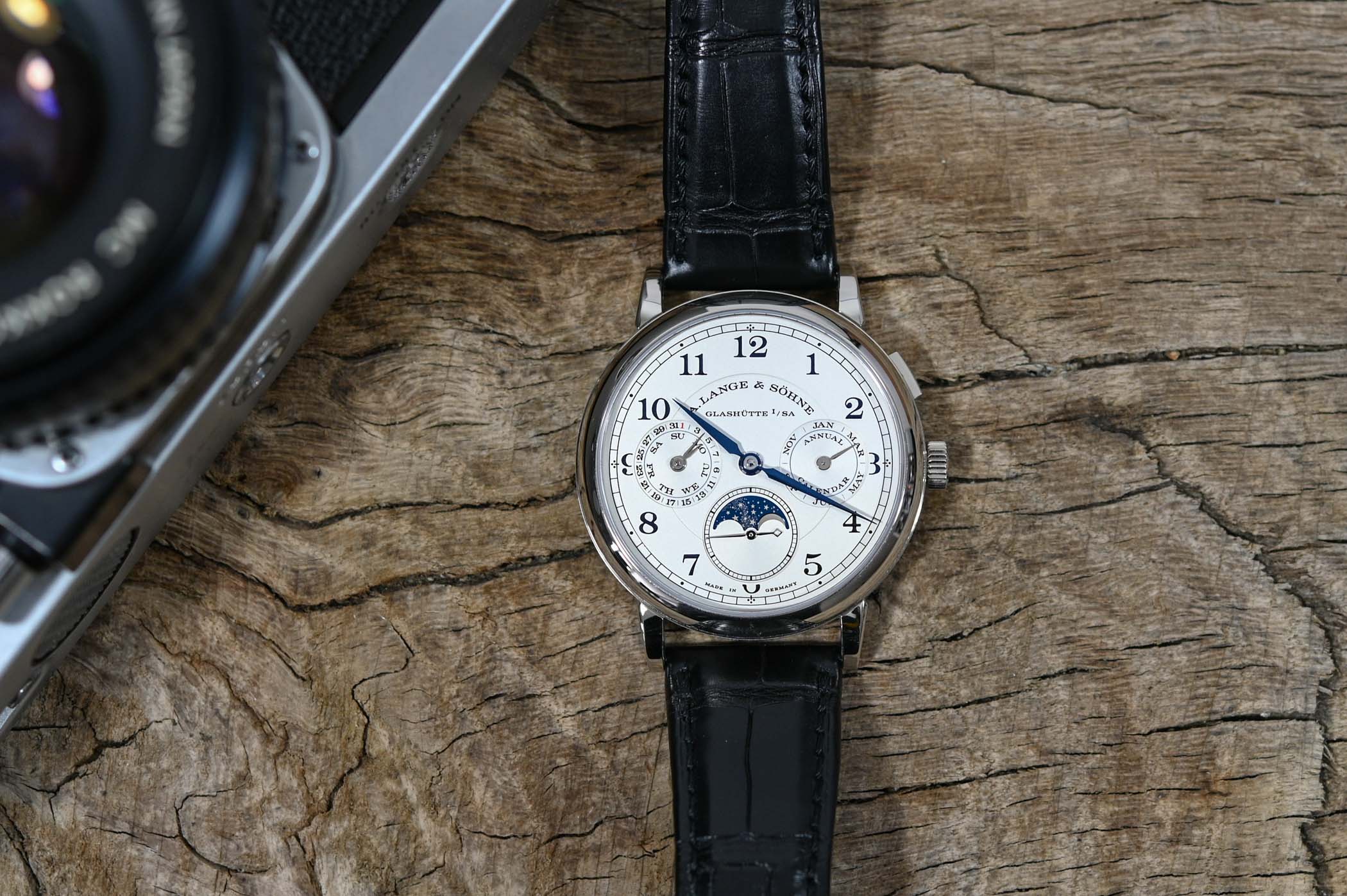

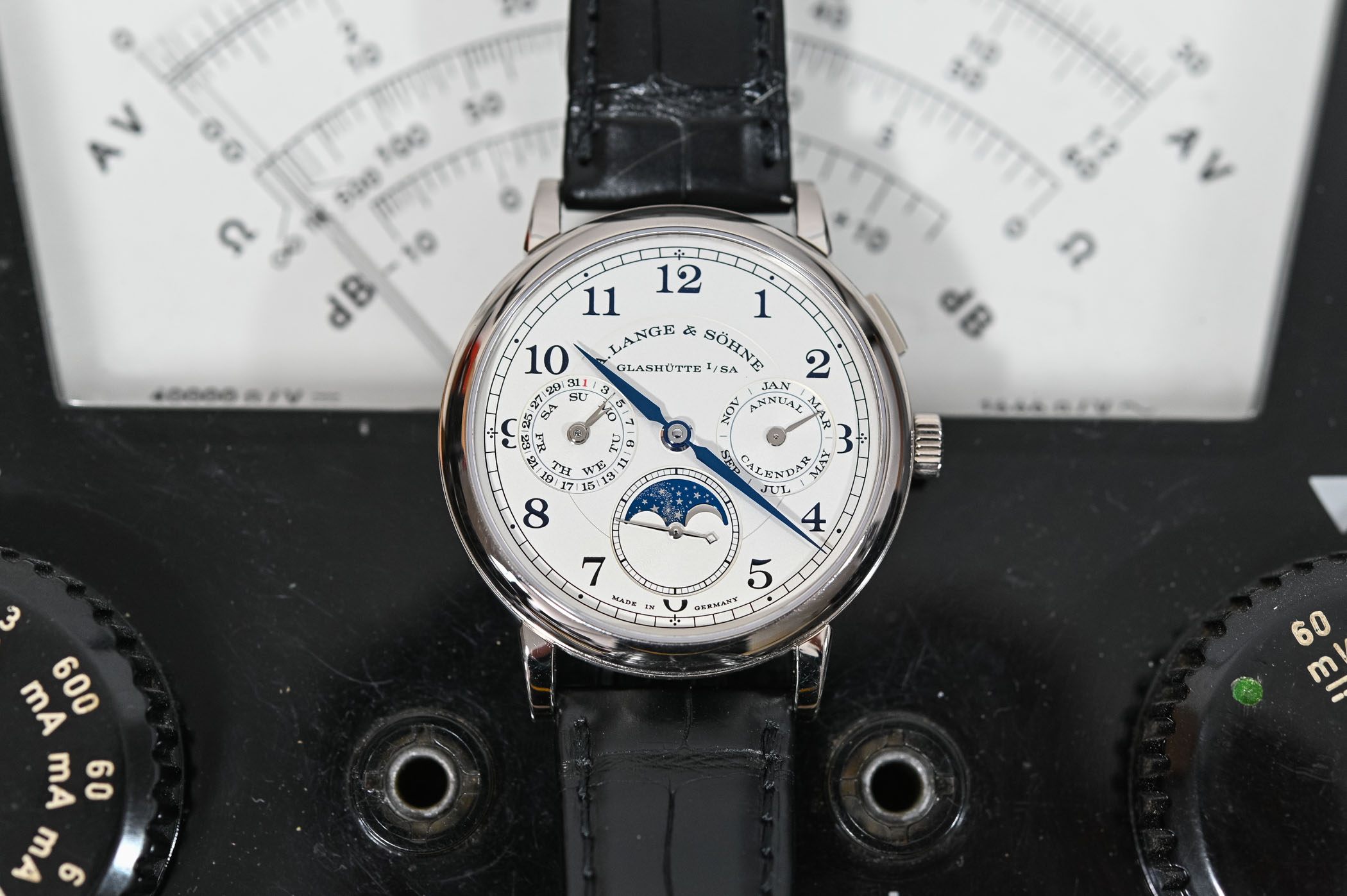


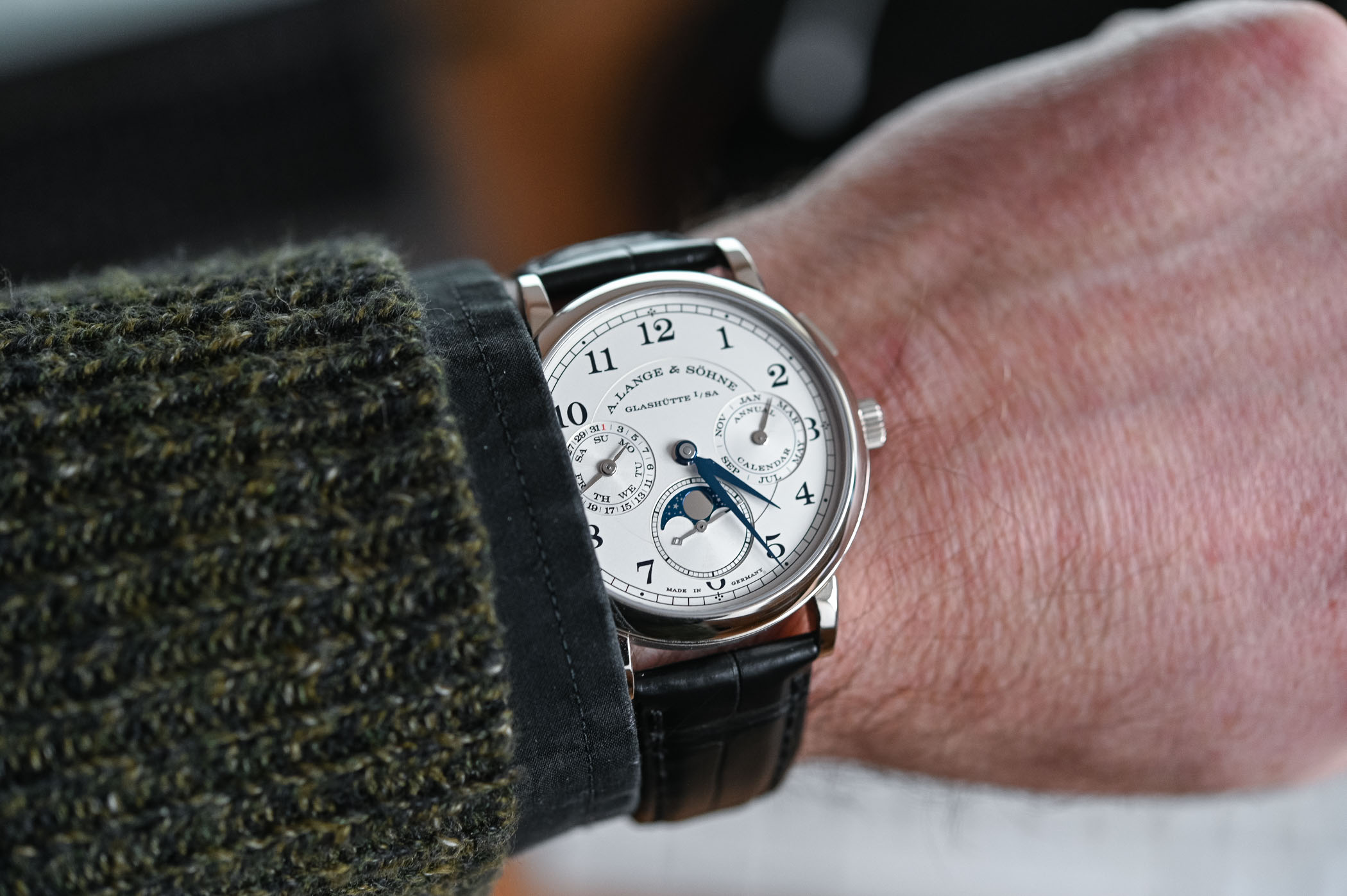

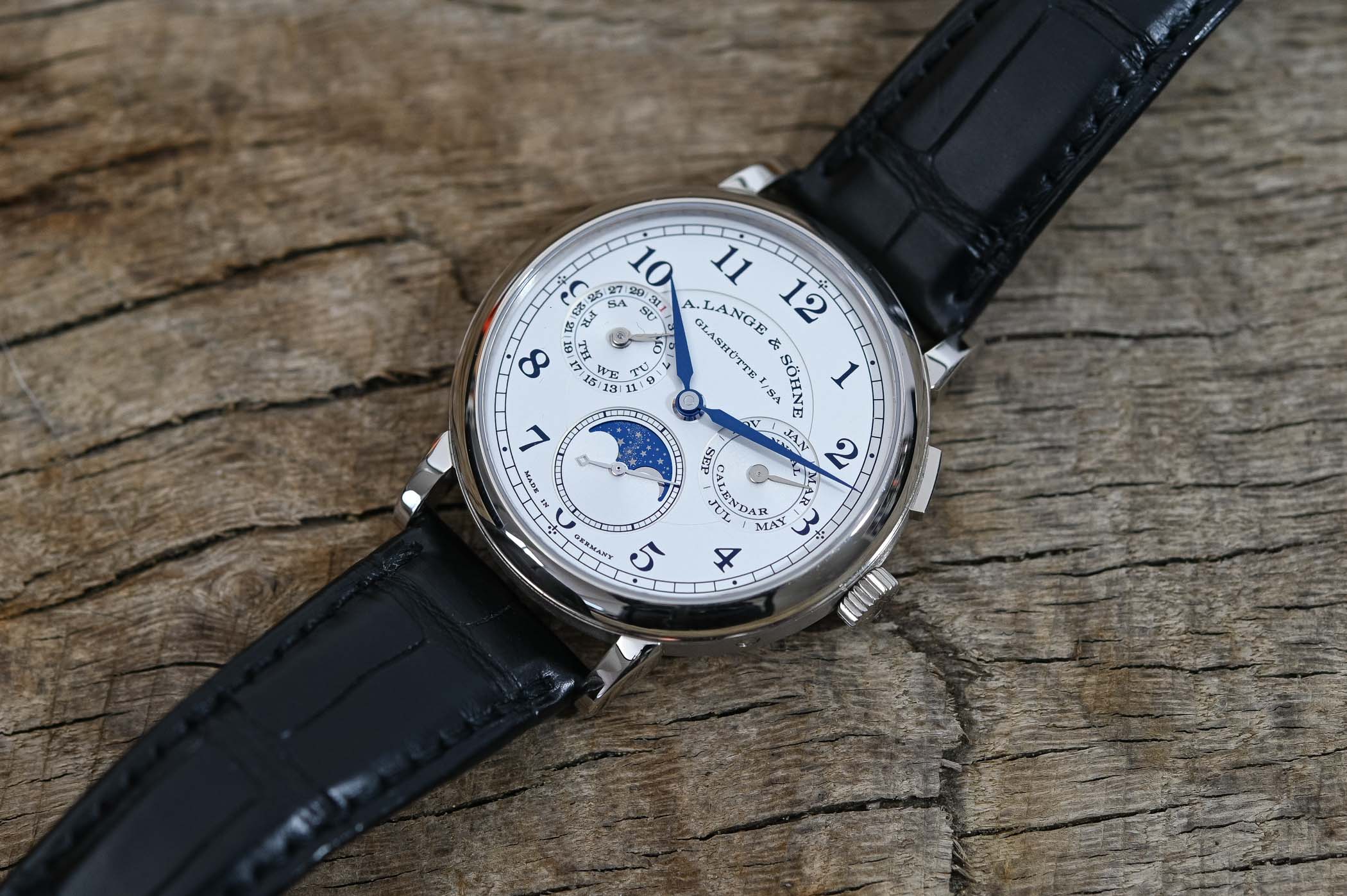


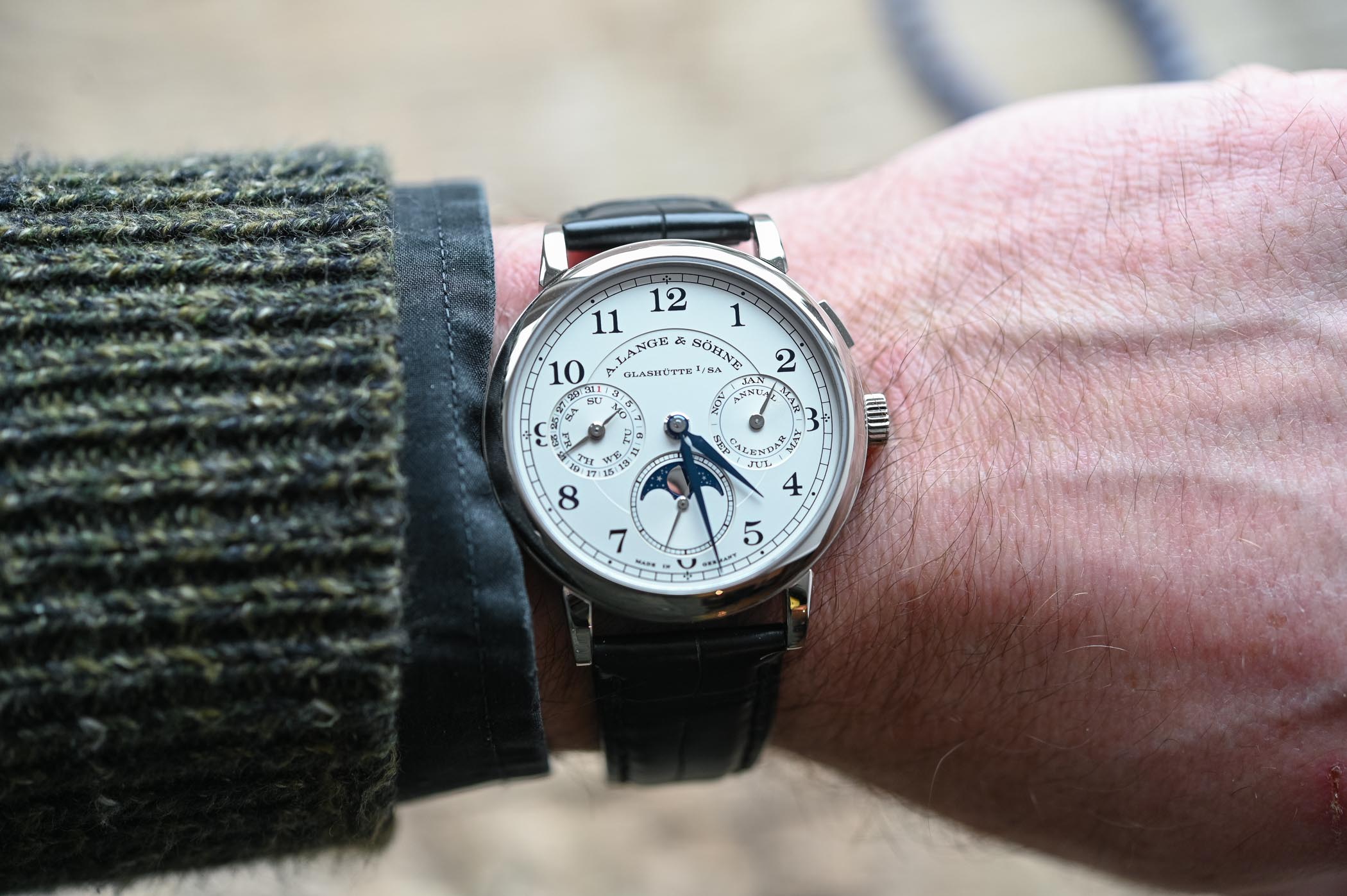

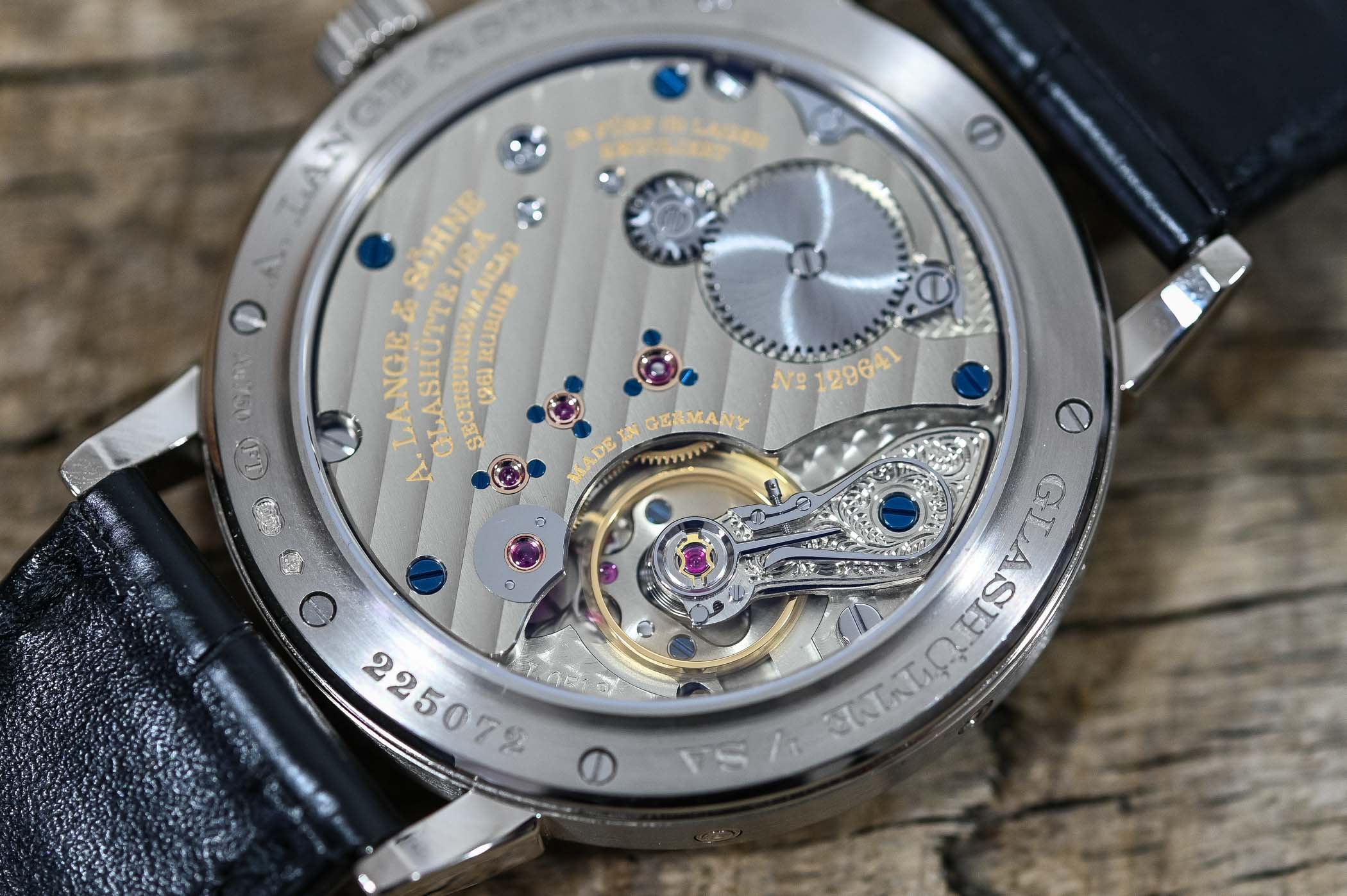



5 responses
Does the button at 2 o’clock move each indication one step by each press? Or why will you need to adjust the date separately?
@Chia-Ming
Was watching a video of someone using it the other day – yeah, the button indeed moves the day, date and moonphase forward simultaneously by one step on each press, and the month hand will jump the whole way from one month to another when appropriate. You would need to adjust things separately if you’d skipped ahead too far, for example, but if you had the watch set up correctly and left it unwound for a while, all you’d need to do is use the button (and of course the crown to set the time).
I’ve got to say, even though it lacks this clever system and has less power reserve, I much prefer the look of the Saxonia Annual Calendar. The baton markers are just more suitable for the busy dial and the outsize date makes it stand out.
I bought this exact watch in white gold just about one year ago. I absolutely love it. I find the dials an endlessly fascinating group to look at and the star clusters in the moon phase are just lovely. It is a joy to wind by hand and an absolute delight to wear. I wear it almost every day and it is very sturdy. The level of detail is amazing and the watch runs just a few seconds fast a day. It epitomizes the joy of owning a mechanical watch. I love the old time design, the railway minute track and the Arabic numbers. The movement is beautiful. After one year I still wouldn’t change a single thing about it. In my humble opinion, Lange got this exactly right.
@Tom C – congrats on this Lange. It is a superb watch indeed. Very wise choice!
Amazing watch an great article. I hope one day to call this watch mine as I do absolutely love it. Would also like to say thank you MONOCHROME and the author because I have less and less tolerance for the absolute nonsense I find on other blogs and I appreciate this blog more and more. great read with my morning coffee today. looking forward to the next 2 installments.